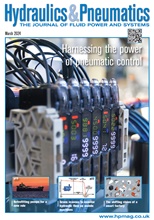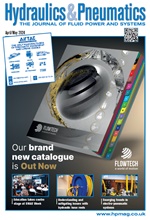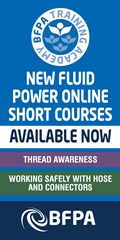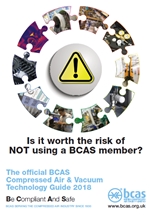Key to optimised pneumatic drives (Oct 2013)
By Gonzalo A. Barillas, Patrick Kinsch, Jürgen Jäckel, and Marco Schönwälder of Freudenberg Simrit.
In addition to miniaturisation, cutting weight and reducing dynamic masses are currently the most important development trends for pneumatic drives. At the same time, material costs have to be reduced, quality levels have to be maintained, and the range of performance should at least be maintained if not increased to meet environmental standards. With Damp & Seal, Freudenberg Simrit offers manufacturers of pneumatic cylinders both a way of achieving significant optimisation and considerable potential for cutting costs. Due to Damp & Seal, it is now possible for the first time to statically seal cylinder caps, provide mechanical cushioning in the end position, and damp the piston stroke pneumatically by throttling air.
In standardised VDMA and ISO cylinders with pneumatic end-of-stroke damping, a lot of axial space is needed in the cylinder cap to accommodate the end-of-stroke cushioning seal that has been used until now. Additional cushioning pads are installed in some cylinder constructions to mechanically damp the piston at the end of stroke. This is all now a thing of the past thanks to the launch of a much simpler solution: Damp & Seal.
The Damp & Seal sealing element combines several functions in a single component. Damp & Seal damps the piston thrust, statically seals the cylinder cap, and dynamically seals the inner diameter of the floating cushion that is connected to the piston. The patented Damp & Seal element is shaped like a disc and is in contact with the front face of the cylinder cap on the pressure side. It has buffers that face into the pressure chamber and damp the mechanical thrust of the piston at the end of the stroke, thereby reducing both acoustic emissions and impact loads. The disc-shaped design simplifies the cylinder cap significantly. It is smooth and mold dependent on the front face, which means that only axial bore holes for the floating cushions and the throttling port are needed compared to previous solutions. There is no need for complex undercuts in the cylinder cap.
As a result of a number of axially arranged bore holes and a ring channel between the front face of the cover and the seal, Damp & Seal is also the link between the end of stroke damping throttle and the cylinder chamber. In order to facilitate rapid ventilation of the cylinder chamber at the start of piston movement, the disc-shaped seal rises slightly, allowing air to flow through the axial bore holes at the same time.
Design, procurement, and assembly advantages
The fact that the undercuts, which were previously needed as a seat for the cushioning seal, are no longer necessary, thus simplifying the design of the cylinder cap, means not only that processing costs for the cap are lower, but also—and above all—that assembly is much easier. Thanks to the ventilation channel that runs around the outside of the element, it is no longer necessary to install the component at exactly the right angle or in a specific position, which means that no mistakes can be made when installing the element, and rejects are a thing of the past. Because a lower number of components now have to be installed, assembly time can be reduced by 50 per cent and more.
Damp & Seal offers considerable advantages in terms of procurement and logistics. By reducing the number of parts required, the number of suppliers has been reduced. The inspection of incoming goods and storage costs have fallen as a result. Other factors that have been reduced include the risk of this element being confused with another and the amount of space required in the assembly cell.
Damp & Seal is already in widespread use. Comparative analyses with cylinders that are sealed using standard solutions have highlighted the significant advantages of this innovative product. Measurement of the damping process and a detailed analysis of motion curves in particular show that depending on the load, the piston's reversal of motion (rebound) in a cylinder with Damp & Seal is only very slight when the throttle is open. Conventional sealing systems with the same setting lead to a rebound of up to 1.5 mm in the first 15 ms. These dynamic cylinder loads are enormous and are transferred to all cylinder components and the cylinder suspension. Cylinders featuring Damp & Seal, however, do not have this problem. The design of Damp & Seal elements and the highly resilient material 85 AU 21030 used in them prevent rebound by allowing the seal to deform in response to the load without causing any wear whatsoever. At the end of endurance tests, no signs of wear were identified either at the damping protrusions or at the dynamically loaded sealing lips. Damp & Seal optimises standard pneumatic cylinders, primarily by:
· Mechanically damping the piston.
· Improving dynamic behaviour.
· Preventing stroke inversion/rebound in the damping phase.
· Reducing the number of components.
· Simplifying the installation area and reducing the costs associated with it.
· Making assembly more reliable.
www.simrit.co.uk
Events
-
Smart Manufacturing & Engineering Week
05 - 06 June, 2024
NEC, Birmingham -
HILLHEAD 2024
25 June, 2024, 9:00 - 27 June, 2024, 16:00
Hillhead Quarry, Buxton, Derbyshire UK










